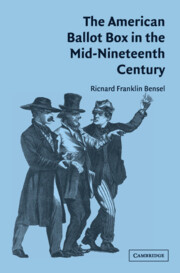Book contents
- Frontmatter
- Contents
- Preface
- Chapter 1 Introduction
- Chapter 2 Structure and Practice of Elections
- Chapter 3 Social Construction of Identity in Eastern Rural Communities
- Chapter 4 Ethno-Cultural Stereotypes and Voting in Large Cities
- Chapter 5 Frontier Democracy
- Chapter 6 Loyalty Oaths, Troops, and Elections during the Civil War
- Chapter 7 Conclusion
- Index
Chapter 3 - Social Construction of Identity in Eastern Rural Communities
Published online by Cambridge University Press: 10 November 2009
- Frontmatter
- Contents
- Preface
- Chapter 1 Introduction
- Chapter 2 Structure and Practice of Elections
- Chapter 3 Social Construction of Identity in Eastern Rural Communities
- Chapter 4 Ethno-Cultural Stereotypes and Voting in Large Cities
- Chapter 5 Frontier Democracy
- Chapter 6 Loyalty Oaths, Troops, and Elections during the Civil War
- Chapter 7 Conclusion
- Index
Summary
From a very general perspective, there were three different venues for voting in the middle of the nineteenth century. For example, many men in the nation's largest cities voted at precincts where party challengers and election officials did not personally know them. With highly transient populations in each neighborhood and very large numbers of voters at each polling place, those attending the voting window usually had little more than a man's physical appearance by which to judge their qualifications and partisan allegiance. While the physiognomy and attire of would-be voters could be visually inspected, reliance on the information thus revealed involved very different practices from those in older, more settled rural communities. In sharp contrast with the latter, the ways in which it was decided who was eligible to vote and which party ticket they might be carrying usually involved stereotypes that did not rely on detailed, contextual histories of an individual. To apply these stereotypes, the crowds surrounding the voting window frequently questioned those approaching the polls, backing up their interrogations with verbal intimidation and physical force. In some cities, such practices appear to have generated the armed political clubs that commandeered precincts in their neighborhoods. Political anonymity thus came at a very high price.
A second, very different venue for voting characterized the western frontier. Situated within an ever-changing social landscape sparsely populated with men constantly moving about in search of good land and economic opportunity, precincts along the line of settlement were places in which anonymous individual voters confronted the petty but nonetheless intense interests of those who ran the polls.
- Type
- Chapter
- Information
- The American Ballot Box in the Mid-Nineteenth Century , pp. 86 - 137Publisher: Cambridge University PressPrint publication year: 2004



